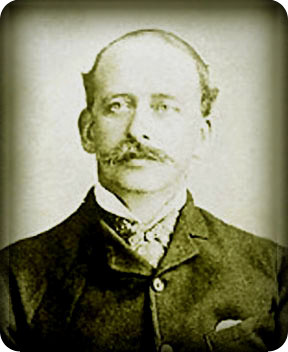
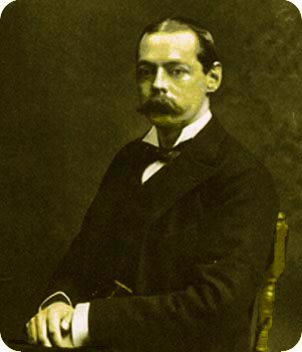
Left, Moreton Frewen; Right, Lord Randolph Churchill.
The failure of the "76" was due not alone to the Great Die off, but also to losses that Moreton incurred at the same time in other speculative schemes.
The first and one which generated mirth and laughter throughout the United States and the Empire was the operation
of a bat cave in Texas. About 1881, Moreton discovered that guano had been used as a nitrate by the Confederate Army in the manufacture of
gun powder as a substute for saltpeter the importation of which was blocked by the Federal blockade.
In the United Kingdom
guano was used as a fertilizer. Moreton made an additional discovery. He wrote his wife, Clara:
"Peruvian guano is now selling in England for £15 a ton, and we could ship and
sell this at a profit for £8, so that if it is nearly as rich,
here is a fortune for sure."
In all of his schemes, Moreton always managed to overlook ome seemingly minor detail necessary to the sucess of the
scheme and the lack of which caused the
scheme to fail. In the instance of the guano, overlooked was that the Peruvian dropping came from sea birds,
whilst the Texas guano was bat
scat. The bat mammalian poop had large quantities of amonium such that miners would pass out from the fumes. The amonium also spoiled its use
as a fertilizer. Frewen gave some of the bat crap to friends who put it upon plants in their gardens. The plants died.
A mining expert William B. Phillips wrote in, Vol. 21 Mine & Mineral Magazine, p. 440,
of his visit to a bat cave that the guano was a "'softish mass' into which one
sinks readily and disgustingly." As
Phillips approached recent deposits in the cave, the
merde became soft and he "mired in it above the knees.
As I was quite alone, and as the light decided to go out just then,
I followed its example."
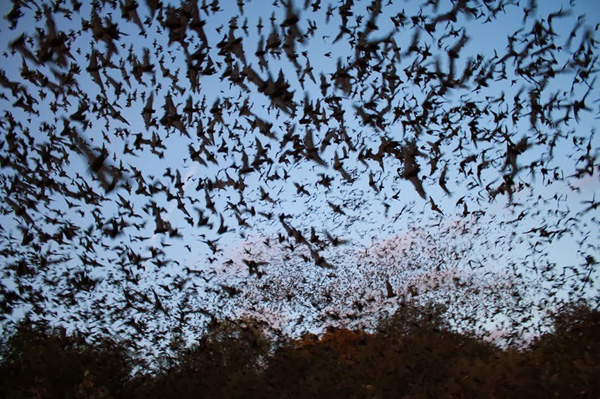
Bats emerging from the Braken Bar Cave near San Antonio.
The whole scheme came to public light when Moreton employed a retired
polo playing British officer Captain Egremont E. Shearburn,(1854-1927), late of the
Ninth Lancers (The Delhi Spearmen) in India,to manage the mine. Shearburn had previously served with distinction
in the relief of Kandehar during the second Afghan War (1878 to 1880) in which the British
secured Afganistan as a buffer between India and Russia.
[Writer's note: The Reader may ask why in a history of Wyoming should we be concerned about the
Ninth Lancers in Afghanistan. It might be answered that the war in Afghanistan has been going on for for some
180 years.
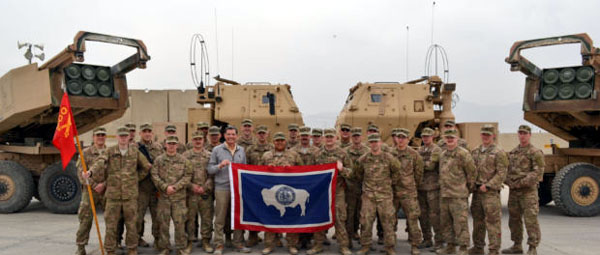
Senator John Barrasso with members of the Wyoming National Guard, B Battery, 2nd Battalion, 300th Field Artillery in
Afghanistran, November 2016.
For more on another member of the Nine Lancers in Wyoming and his influence on Sheridan County and the Boer War and its influence see
Sheridan. As to the Second Boer War, see
Birney.
Horace Plunkett, a neighboring ranch owner, ran into Shearburn when stopping by Richard Frewen's. Plunkett wrote in his diary for
8 Jun, [1881:] Wed Captain Shearburn – IX Lancers who has been prospecting round
here for some months accompanied me back to our Ranche.
He was in an affair which eclipsed Balaclava in the Afghan war,
having charged with 120 men 17 times against 10,000 men. His
horse was shot under him and he had extraordinary escapes, his
clothes being riddled. Out of the 120 only 42 survived. On
another occasion he rode 170 miles in enemy’s country in a day.
Fired on all the way.
9 Jun, Thu To continue about Shearburn. He lost all his money gambling and
had to leave the army. He came out here in Feb. Got a bad fall
from a horse and was in McKinney hospital for some weeks. Is
well again now and hopes to go into cattle business. Talked of
buying out a neighbour’s herd. We talked of going in with him.
But on the whole it will hardly come off as the feeling of the Firm
is against authoritative inexperience.
In the Second Afghan War, Shearburn saw service at Kabul and near Kandehar.
The arrangement for operation of the
Bat Cave was such that Captain Shearburn was to cover his expenses by
drafts on a Frewen account in the M.E. Post Bank in Cheyenne. Needless to say,
the covering of expenses ended. His draft was dishonored by the Frewens.
Shearburn had extensive credits in his account in England managed by his
by his mother. The M. E. Post Bank drew on the account in England. Shearburn's Mum wondered
about the strange drafts from Cheyenne and held up the draft until she could complete inquiries.
M. E. Post bank filed felony charges against Shearburn. A deputy was sent to Texas to arrest
and return him to Cheyenne to face charges.
In Cheyenne, the Court, after trial, dismissed the
charges against Shearburn since his account in England had more than sufficient funds.
The publicity given Captain Shearburn's arrest and trial brought the bat scat scheme to light.
Laramie's Bill Nye made fun of Frewen in his book "Bailed Hay":
AN INFERNAL MACHINE
A SINGULAR thing occurred in England the other day, and in view of its
truth, and also in order that the American side of the affair may be shown
in the correct light, we give the facts as they occurred, having obtained
our information directly from the parties who were implicated in the
affair. We hesitate to take hold of the subject, but our duty to the
American people demands some action, and we do not falter.
During the past winter there arrived in London a suspicious-looking
metallic box, with a peculiar thumb-screw or button on the top.
It was sent by mail, and was addressed to a prominent land owner.
This gentleman had been on the watch for some explosive machine for some time,
and when it was brought to him, he at once turned it over to the
authorities for investigation. The police force, detective force and chemists were called
in, and requested to ascertain the nature of the infernal machine,
and, if possible, where it came from.
Experts examined the box, and, with the aid of a cord
attached to the suspicious button on top, pulled open the metallic box
without explosion. The substance contained therein, was of a dark
color, with a strong smell of ammonia. All kinds of tests were made
by the experts, in order to ascertain of what kind of combustible it
was composed. The odor was carefully noted, as well as the taste,
and then there was a careful chemical analysis made, which was
barren of result. In the midst of the general alarm, the London
papers, with large scare-heads and astonishers, gave full and
elaborate reports of the attempt upon the life of a prominent man,
through the agency of a new and very peculiar machine, loaded with an
explosive, of which scientists could gain no knowledge or information
whatever.
It looked as though the assassin was far in advance of science, or at
least of professional chemists, and the matter was about to be given up
in despair, when the following letter arrived from San Antonio, Texas,
United States of America:
"My Dear Sir:
I sent you by a recent mail, prepaid, a small metallic box of bat
guano, from the caves of Texas, for analysis and experiment. Please
acknowledge receipt of same.
"Morton Frewen."
Then the experts went home. They felt as though science had done all
it could in this Case, and they needed rest, and perfect calm, and
change of scene. They hadn't seen their families for some time, and
they wanted to go home and get acquainted with their wives.
They didn't ask for any pay for their services. They just said it was
in the interest of science, and they couldn't have the heart to
charge anything for it. One chemist started off without his umbrella,
and never went back after it.
When he got home he was troubled with nausea, and they had to
feed him on cracker toast for several weeks.
We tell this incident simply to vindicate America. The London papers
did not give all the proceedings, and we feel it our duty to place
the United States upon a square footing with England in this matter.
Of course it is a little tough on the experts, but when we know
our duty to our magnificent country and the land that gave us birth,
there is no earthly power we fear, no terrestrial snoozer who can
deter us from its performance
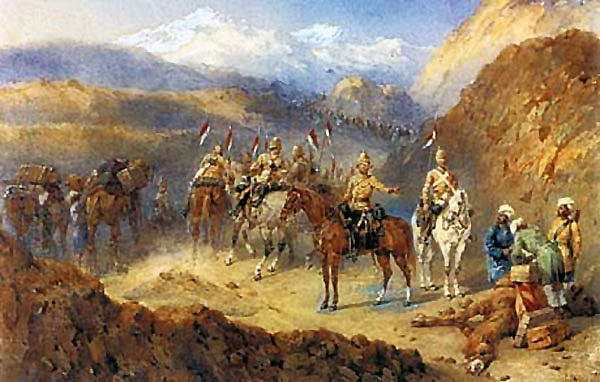
9th Lancers on road from Kabul to Kandahar, 2nd Afghan War.
Even though the Frewens sold the cave and recouped some of the losses,
Moreton lost some $6,300 [equal to over $35,000 as of 2018] in the droppings. We do not know how much
Richard Frewen and Captain Shearburn lost. Captain Shearburn returned to Her Majesty's service,
but at a lower rank. He later served during
the Second Boer War with Major E. C. Bethune's Mounted Infantry Corps.
His Queen Victoria campaign medal with five clasps (South Africa 1901; Laing's Nek; Transvaal; Relief of Ladysmith and Tugela Heights) was sold
in 2015 for £600 at a British auction house to a buyer bidding online from Zimbabwe.
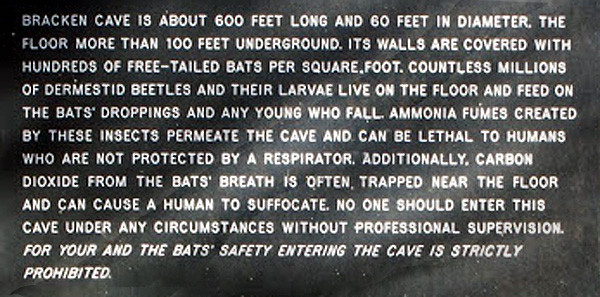
Warning sign at Braken Bat Cave.
A second money losing venture was the construction of a meat packing plant on Sherman Hill west of Cheyenne.
The idea was that since from August on just about every night it gets down to freezing,
artificial refrigeration or ice would not be needed.
The meat could be held permitting production and shipping to be balanced. The meat would then be shipped by refrigerated ship to
Gravesend at the mouth of the Thames. In 1881, just about the same time the Union Pacific was building
its monument to the Ames Brothers, construction began on the
Frewen meat packing plant. The plant consisted of two buildings, one measuring
140 by 40 feet and a second measuring 290 feet by forty. See Cheyenne Daily Sun,August 29, 1891, p. 4.
In addition there was an associated sheep operation. Moreton promised that the packing operation
would result in increased sales of a least 30%. See Clay, John, "My Life on the Range," p. 195. Frewen indicated that after the first year's
operation, there would be shipped some 10,000 head. See Weekly Leader December 29, 1881, p. 8.
There was no second year's shipments from Sherman. Indeed, there was no first year's shipment. Again, Frewen missed a minor detail: Although at night it may get down
to freezing, during the day the sun shines, it warms up and the meet spoils. See the Sheridan Post, May 12, 1916, p. 6.
In response to a reference in another paper to Frewen as a financial expert, the
Cheyenne Daily Sun August 29, 1891, page 4
noted:
If a monument of his financial sagacity is required it can be found on the
hill near Sheman, the highest point on the Union Pacific railway.
We believe that a small portion of the immense packing establishment there erected by Mr. Frewen still remains.
The putrid carcasses of cattle and sheep, which gave such offense to the people of Sherman, have long since been removed, and
the cattle that stampeded at the sight of the
buildings are widely dispersed. We might cite other instances to illustrate the value o( Mr. Frewen's schemes, but
the mere mention of his name is sufficient to provoke a smile of incrudulity.
No meat was ever shipped and the project was halted before completion. Thus, it was left to Horace Plunkett to clean up the mess on Sherman
Hill. Governor B. B. Brooks, see Memoirs of Bryant B. Brooks, later referred to the project as "foolish" and proving that one cannot operate
a ranching operation from an office abroad. Plunkett was less polite referring to the packing plant as
Frewen's Folly. The Daily Sun was not the only one to refer to the packing plant as a
"monument." Earlier in his diary, Plunkett noted the proximity of the
packing plant to the Ames Mondument:
Went with a lumber merchant to Sherman to measure Frewen’s
folly, the Packing house & see what it was worth as old lumber.
Funny the two monuments on the Rocky M[oun]t[ain]s, at
Sherman one on south side of track to Oakes Ames of Credit
Mobilier fame & on the other side the monument of Frewen’s
folly & the British investor’s [sic] gullibility. Plunkett Diary, November 6, 1887.
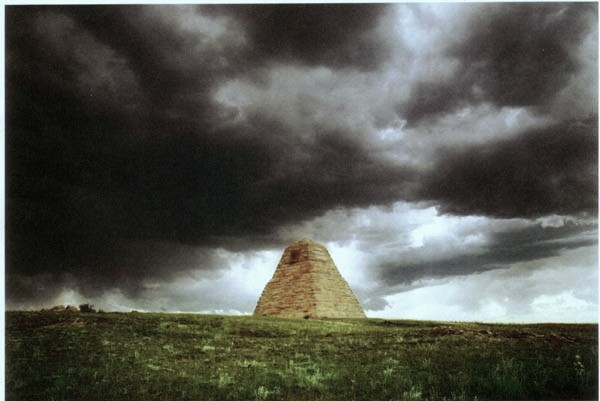
A storm gathering over the Ames Monumnent, Sherman Hill, National Park Service Photo.
As early as 1884, Frewen proposed another scheme, a new route for
live cattle shipments to England. The
cattle were to be transported by rail from Cheyenne
to Duluth. Then shipments were to be made by steamer
over Lake Superior and Georgian Bay and then by
rail to Quebec. Steamers were then to carry the stock
to Liverpool. The plan was intended to avoid pooling
interests in Chicago and to save six hundred miles of
land and nine hundred of ocean travel. In South Superior Frewen constructed a cowshed to house the cattle during the frigid winters of
South Superior. The walls were insulated with sawdust and the cattle crammed in. Thus, the body heat given out by the
cattle precluded the interior from freezing and heat was not required.
The Frewens employed Frederick R. Lingham (1854-1912) to manage the operation. Lingham was a timber merchant.
The following year the first shipment of cattle from Richard's Ranch and Moreton's Powder River ranch
was made out of South Superior. By 1886 Frewen had left Wyoming and was living at Superior attempting to breath life into the
feed lot operation. He overlooked that both Messers Swift and Armour had opeations in nearby Duluth. By 1886 Swift owned 900 patent refrigerator cars, something that Frewen could not compete
with. They undercut him badly.
Missed also was that South Superior was about to take off and real estate would be a gold mine. Businesses flocked to the area.
These included Campbell Lumber, Duplex Manufacturing Company, Duplex Windmill Manufacturing Company, amd LaBelle Wagon Works.
Perhaps the least known of the businesses located here was the stub-track-served stock yard and slaughter house once located in the shadow of Central Avenue tower.
Frewen always seemed to lose out on fortune by selling out cheaply and too soon. such was the case in South Superior. He sold out
early and at a loss. As always in need of money, he sold out
at a loss and departed for the United Kingtom to lick his financial wounds. About 1887, South Superior began to take off. South Superior was the junction of
The Great Northern and the Northern Pacific. Many businesses began to locate there because of the junction and the port built in the area.
foremost among them was the La Belle Wagon works. La Belle measured right up there with other
wagon manufacturers such as Studebaker, Deere, Moline, and International Harvester.
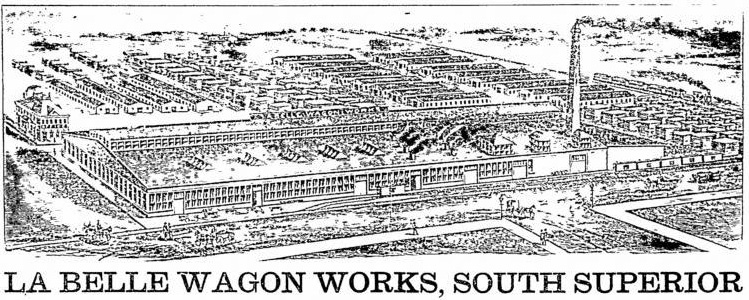
La Belle Wagon Works, South Superior.
Lingham, on the other hand, continued an operation of shipping live cattle and timber abroad to South Africa and made a fortune..He ultimately
owned his own shipping line.
Twelve years later the June 24, 1897 issue of
"Wool Markets and Sheep,' p.3 noted someone else was proposing the same scheme:
The owners of the tract of five acres of land and old factory buildings
located between the Great Northern and Northern Pacific railways at South
Superior, Wis., formerly the La Belle Wagon Works, are negotiating to turn
it into a sheep depot. The proposition is to bring from the Montana ranges
sheep and fatten them here with screenings from the flouring mills, which
can be had very cheap. The owners of the property had almost gotten a
contract closed with Ray Bros., of Montana, who would have leased for
six years and brought here to fatten a hundred thousand head of sheep
annually, but at the last moment they chose the Brighton yards, near
Minneapolis. The old plan of the Powder River Cattle company contemplated
this plan and the promoters of it twelve years ago,, the famous Marquis
De Mores and Morton Frewen invested thousands of dollars here before
their project fell through. The result of their labors still stands here
in the abandoned stock yards at East Superior, ten miles from the city.
Richard Frewen left for China. During Moreton's seven years in
Wyoming, not only had the Powder River cattle operation lost money, but the
Sherman Hill meat packing plant lost money, was abandoned, and sold for scrap lumber by the liquidator and substantial
moneys were lost in the speculative operation of a bat cave. As early as 1881, Horace Plunkett had observed the diffeence beween the
two brothers, Richard was "crotchety" in business and Moreton was "regardless of value of money." Plunkett Diaries,
July 28, 1881. For the rest of his life, Moreton failed to learn the lessons. He seemingly followed the same road
to the end in
a vain attempt to find wealth. It was as if he was living the life described by
Sir Harry Lauder:
Ev'ry road thro' life is a long, long road,
Fill'd with joys and sorrows too,
As you journey on how your heart will yearn
For the things most dear to you.
With wealth and love 'tis so,
But onward we must go.
Chorus:
Keep right on to the end of the road,
Keep right on to the end,
Tho' the way be long, let your heart be strong,
Keep right on round the bend.
Tho' you're tired and weary still journey on,
Till you come to your happy abode,
Where all the love you've been dreaming of
Will be there at the end of the road.
Following the failure of the operations in Wyoming, Frewen returned to the United Kingdom. He was penniless. In 1883, his father-in-law Leonard Jerome acquired suitable
housing for his daughter and Moreton in newly redeveloped Mayfair at 18 Aldford Street (formerly Chapel Street) just down from Grosvernor Chapel. When Leonard
Jerome died in 1891 in Brighton to which he had been sent for his health, the funeral was conducted at the chapel. Among those attending were Robert Todd Lincoln, the
American and German ambassadors to the Court of St. James.
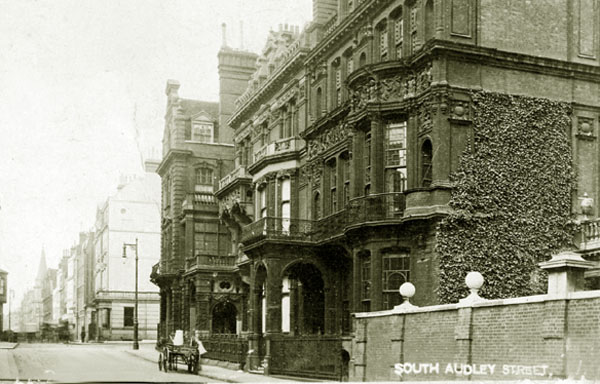
Aldford Street looking east 1906. At the end of the street through the fog may be seen Grosvernor Chapel. 18 Aldford would have been located in
the foggy area on the right-hand side of the street. The house was later razed.
At the time the Frewen's acquired 18 Aldford Street, the area was just being redeveloped from an area of modest
houses and bars with barns and stables behind the houses to one occuppied by mult-storied red brick townhouses decorated with white stone work.
The street name was changed. The Frewen house although large, faced north. The interior rooms with the gas lamps of the time were dark.
Frewen's daughter Clare, recalled that the children's nursery smelt of gas.
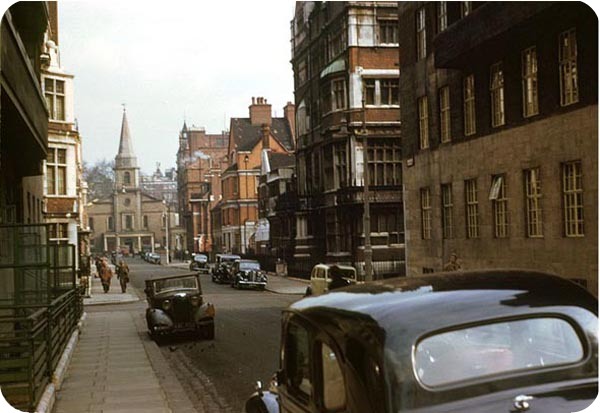
Grosvernor Chapel at east end of Aldford Street, approx 1949, Photo by Chamers Butterfield. [Use of this photo, requires credit to the photographer.]
The house that Leonard Jerome paid for was promptly
mortgaged. But at least termporary financial
salvation would come from Moreton's brother-in-law Lord Randolph Churchill. Southern India's Hyderabad
was governed by a hereditary Nizam.
The chief advisor to the Nizam
was Mir Laiq Ali Khan Salar Jung II, also occupying office on a hereditary basis.
.jpg)
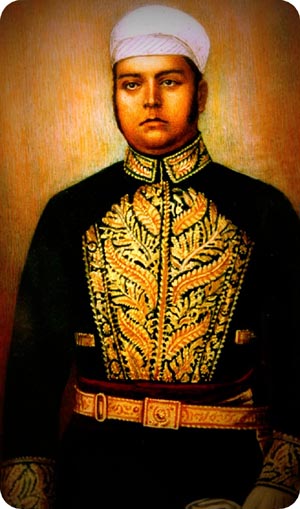
Left: His Highness, The Nizam; Right, Salar Jung II.
Jung was young, inexperienced and overweight. Hyderabad's administration was
allegedly corrupt and there was a brewing scandal which it was feared might reach into the Vice-Regal office.
It was alleged that Salar Jung had smoked in the presence of the Nizam and had otherwise been disrespectful.
Lord Randolph had served as Secretary of State for India, had travelled to India, and served as
Chancellor of the Exchequor.
Lord Randolph was requested to find someone who could act as an adviser to
Salar Jung. Frewen was recommended by Lord Randolph to act as
private secretary, and financial advisor to Solar Jung. Additionally he was to guide Jung on an extended trip to the Ottoman Empire, Egypt, and
Europe. It has been suggested that Frewent was also to keep Jung away from Queen Victoria's Jubilee.
Frewen was to be handsomely compensation by Jung:
initial payment of £250 (about £17,000 as of 2018),
a monthly salary of £100 (nearly £7,000 in modern terms) with all expenses paid. Thus, unintentionally or otherwise,
Lord Randolph solved four problems in one fell swoop:
(a) Moreton was sent away, out of sight, out of mind; (b) an income was provided for Moreton who "discovered" the corruption which
was quietly corrected without embarassment to the Nizam
or Queen Victoria's Viceroy; (c) Jung was kept away from the Jubilee, (d) and
the disrespect shown by Jung to his previous good friend the Nizam was resolved.
By the time Moreton arrived in Hyderabad,
Solar Jung had been dismissed. Nevertheless, Frewen was employed. Later Moreton claimed that
it was he who had discovered the
corruption. Moreton was successful in guiding Salar Jung to Turkey where he found a wife for
his employer in a Turkish Harem and kept his employer away from the Jubilee.
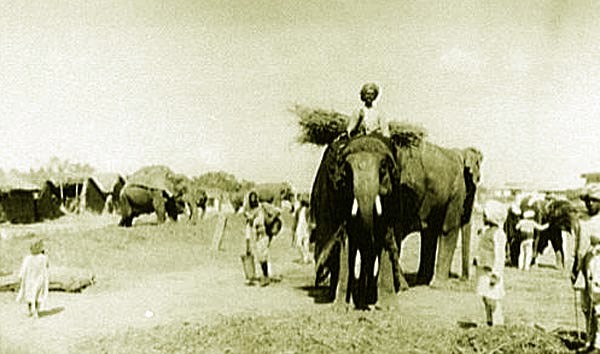
The Nizam's Elephants, 1895. Photo by William Henry Jackson.
The great Western photographer William Henry Jackson visited Hyderabad in 1895. Winston Churchill was briefly stationed in
Hyderabad in 1896. In a letter home to his mum, Lady Randolph Churchil, the young Churchill half facitiously wrote that Europeans rode
the elephants because,
“You dare not walk on the roads here as the natives spit at Europeans – which provoke retaliation leading to riots”.
The mystery in Hyderabad was, however, how could Lord Randolph with a straight face recommend
his brother-in-law as an experienced financial advisor when Moreton in the space of a few years had squandered
his inheriance. He failed in addition to the Powder River Ranch, in the promotion of the Sheridan Hill slaughter and packing house, the
Superior, Wisconsin, indoor feed lot and port, and the promotion of bat dung.
The Daily Yellowstone Journal, November
16, 1887 reported:
They Never Get Left.
Just think of it, Moreton Frewen is secretary, financial agent, etc.,for a Hindoo rajah at a salary of £L100 sterling per month,
and is now taking in India in grand style. There is no such thing as keeping a
good man down as long as this world is as large as it is.
Richard Frewen is making himself useful to his old friend Mackey,
the wealthy ex-Califonian,in
looking after his railroad scheme in China.
If Mackey, the Rothchilds, Jay Gould and a few rich rajahs
would furnish the capital we promise the Frewens will supply
sufficient experince to manipulate it. Even the United States
surplus which is giving this adminisation so much annoyance,
would not stagger Moreton, single-handed.
In Hyderabad, Moreton spotted someone he knew. It was Captain Shearburn. Shearburn was a gentleman. He said
nothing and instead turned his back on
Frewen and walked away. Following his unwelcoming in Cheyenne, Captain Shearburn returned to India
and re-inlisted at a lower rank than he held before. later he served in the 2nd Boer War.
In one of the few successses of his life, the adventures in Hyderabad turned out sucessfully for Moreton. At the time he left, he took not only the accumulation from the
generosity of Solar Jung, but a substantial termination bonus offered to him as a pension or as a lumbp
sum. It may be speculated that the termination bonus was paid to induce
Frewen to leave. Everywhere he went at the end, Frewen left a bad taste in the mouth. It was not just
Captain Shearburn who declined to talk to Frewen. In his diary for July 27, 1905, Horace Plunkett noted that had driven through Innishannon
where Morton was then living. He recalled that he had not spoken to his old partner since 1884. Plunkett did not stop.
Frewen took the lump sum and returned to Aldford Street. But as the Yellowstone Journal put it, with the world as big as it is, you can't keep a good man down.
Next Page, Moreton Frewen and the Gold Crushing Machine, Bimetalism.
|